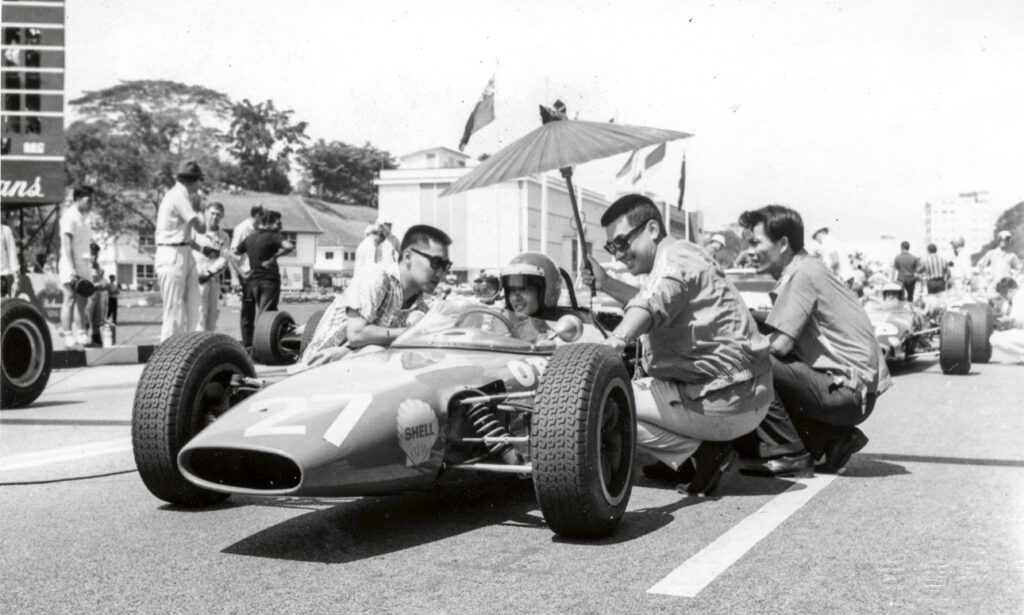
Rodney Seow on the front row for the 1968 Johore Grand Prix. To his left are Stanley Leong (holding the umbrella) and Singapore Motors mechanic Chuang Peck Siang. To Rodney’s right is 1967 Johore Grand Prix winner Lee Han Seng. In the background are Dickie Arblaster (with cap) and Jan Bussell (in race suit).
This is the final part of the three-part series on the history of the Johore Grand Prix
By Eli Solomon
The tragedy of Yong Nam Kee’s accident in the 1963 Johore Grand Prix put a dampener on the sport in South East Asia for a short period of time. It wasn’t long before Yong’s friends were back in the saddle and looking to perpetuate his racing spirit. In the meantime, the major motor racing events in Selangor and Singapore blossomed while Johore came to grips with the cost of hosting a race around the centre of a bustling town.
The Malayan Motor Sports Club (MMSC), formed in 19531, championed the cause for racing in Selangor (and the Malay Peninsula). There was a push for a permanent circuit and this finally materialised through corporate funding. The burgeoning industrial development in the Batu Tiga/Shah Alam district outside Kuala Lumpur was selected for the new circuit.
Recall that in March 1960, the newly developed Diplomatic Enclave of Kenny Hill and the Lake Gardens came alive with the vibrant, discordant sounds of production and race cars from the furthest reaches of the Peninsula2. The MMSC initially faced stiff competition from regional and local events such as the Upper Thomson Road street Grand Prix in Singapore and the Johore Grand Prix in Malaysia, but by August 1967, Selangor had its own permanent circuit with full facilities, the first such complex in Asia outside of Japan.
STEPPING UP
Following Johore’s reluctance to host a Grand Prix in 1964, it was left to the MMSC to host major events in Malaysia, and Selangor naturally became the primary location for such events.
In 1966, the 5th TAR races were held at a site near Sungei Renggam in Selangor, yet another temporary location, but one which the organisers hoped would accommodate 50,000 spectators and eventually be transformed into a permanent racing complex. This complex was completed and ready for the 6th TAR meeting in 19673. The Batu Tiga circuit transformed the complexion of the sport in the region and firmly established Malaysia as a serious venue for motor racing.
The Batu Tiga circuit transformed the complexion of the sport in the region and firmly established Malaysia as a serious venue for motor racing.
It certainly galvanised the powers that be in Johore and Singapore, and what better excuse for another Grand Prix around the streets of Johore Bahru than to celebrate the 10th anniversary of Malaysia’s independence from colonial rule?
BACK ON TRACK
After a hiatus of three years, there were stirrings in 1966 of a revival of the Johore Grand Prix. Two key parties were involved. The first was a willing organiser – the Singapore Motor Club (SMC). The second was H.R.H. the Sultan of Johore, a keen motoring fan, who gave his blessings.
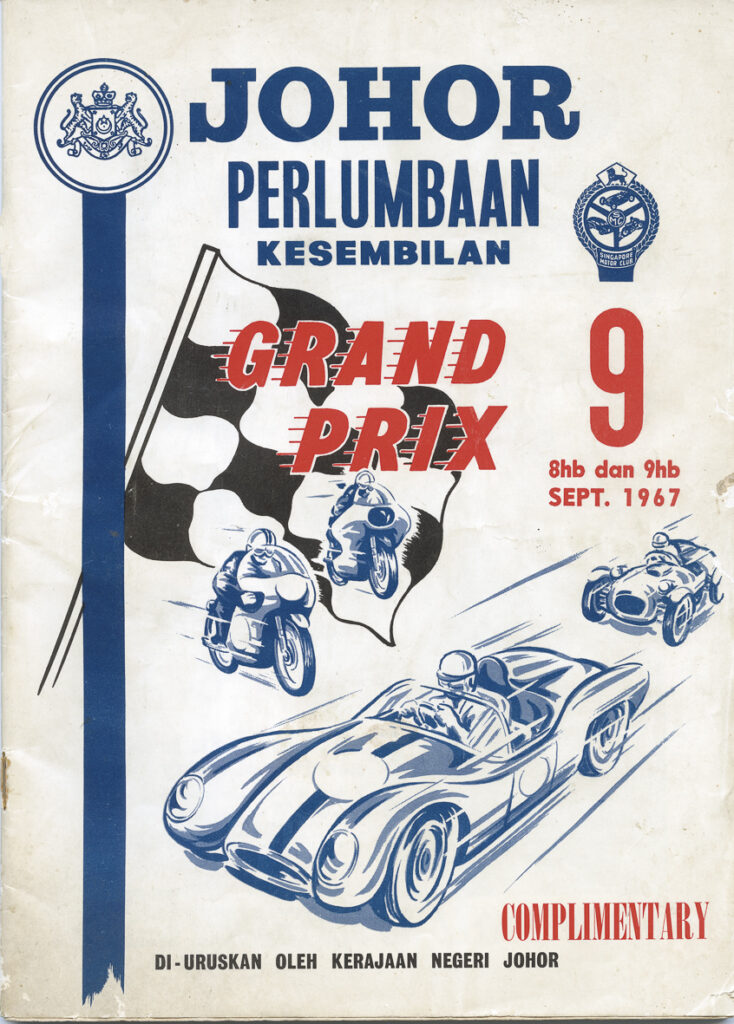
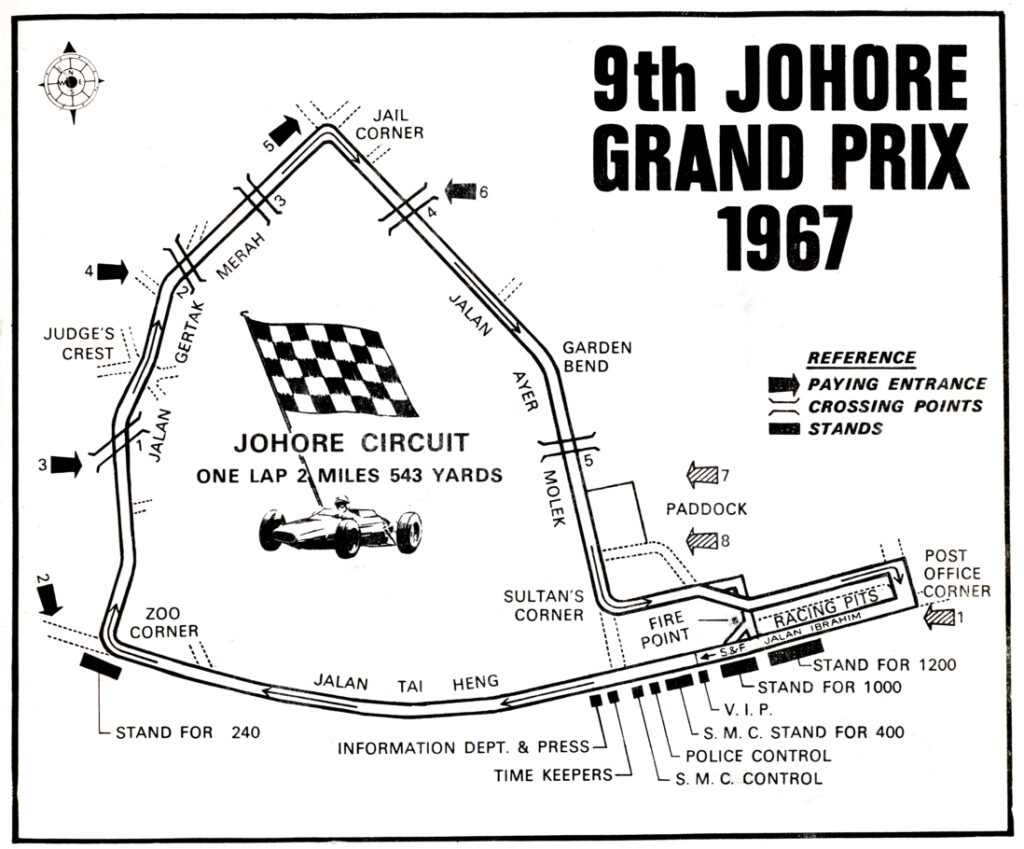
Having seen how successful Singapore’s first post-independence Grand Prix was in 1966, and the developments taking place for a permanent circuit at Batu Tiga, it came as no surprise when talk of a Johore Grand Prix made its rounds within the regional motor sports clubs as early as September 1966.
NEW PUSH
A proposal by the Singapore Motor Club to the Johore State Secretary Dato’ Abdul Rahman Jaffar for a Grand Prix in Johore in 1966 fell on deaf ears. Sentiment turned for the better when Dato’ Abdullah bin Mohamed D.P.M.J, P.I.S assumed the role of State Secretary in January 1967. The new State Secretary was keen to have the event run in 1967, giving it top priority when it came to budget estimates for the year. Nothing more was heard until 2nd June 1967 when news finally filtered out to the media. “Bid to revive Johore G.P.” made it into an inconspicuous part of the Straits Times’ sports pages.
That year, the SMC was led by schoolmaster and motor sport enthusiast Francis Baruch, just one of the new breed of locals who had taken over from expatriate enthusiasts. The club had been behind the Johore Grand Prix since its inception in 1948 and continued to play the role of organiser until the last race was held in 1963. Baruch and his committee were eager to revive the event. Facilities were in place and the club had a good relationship with the Johore Royal family, a perquisite for the race to happen in the State.
Timing was straightforward – the race would be over a weekend following the 6th TAR Circuit Races at Batu Tiga in early September 1967. The club also boldly mooted the idea of an Asian racing circuit that would include Hong Kong, Japan, Johore, Macau, Manila, Selangor and Singapore. It was just a pipe dream but it was the forerunner to something much bigger4.
There was every intention to run the proposed Johore Grand Prix on the same roads as it was in 1963, 2.2-miles in the heart of town and right across from the Causeway linking the newly independent island of Singapore with the Malaysian hinterland. The Johore Government pledged $100,000 (£13,600 or USD32,640…or USD228,000 in today’s value) for organisation expenses with profits from the event going to welfare and youth bodies in the state.
It would, at the same time, celebrate ten years of independence. The retailers loved it, it helped the charities, and it was a good reason for southerners and tourists to flock across the Causeway for a weekend of action.
That the Johore Post Office had to be shut down for the weekend to make way for the racing was incidental. Even the cinemas caught on, playing John Frankenheimer’s 1967 epic movie Grand Prix5 on their screens. The date of the 1967 race was set for 2-3 September.
Even the cinemas caught on, playing John Frankenheimer’s 1967 epic movie Grand Prix on their screens.
NEW BORDER
There were some fundamental changes to the geopolitical landscape post Singapore’s independence from Malaysia in August 1965. As of 12 June 1967, there were then two distinct monetary policies, and currencies, with both countries issuing separate currencies pegged at parity. Independence also meant that the old ‘customs hut’ at the Causeway linking Singapore to Malaysia now functioned an immigration post as well.
Johore Customs made a point of advising travellers during the race weekend to bring as little as possible to avoid delays at customs. Cameras and transistor radios were scrutinised (and taxed) if not for use over the weekend. All this came as a shock after years of free movement between the neighbours.
STAR ATTRACTIONS
With the 6th TAR race (it wasn’t considered a Grand Prix until the following year) attracting over 250 entries to Batu Tiga the previous weekend, Johore’s race weekend was a guaranteed success.
However, some of the glitter of the Japanese works motorcycle entries at Batu Tiga was dulled when Yamaha withdrew top rider Hiroshi Hasegawa and instead sent Shigeyoshi Mimuro, winner of the 100cc, 125cc and open events at the 1967 Indonesian Grand Prix. The Johore event, however, appealed to Yamaha, and the factory were hopeful that Hasegawa, who was testing Yamaha’s new RD05A 250cc machine for the Japanese Grand Prix later in the year, would be available for the Johore weekend. Yamaha’s Akiyasu Motohashi had won the Selangor Grand Prix for motorcycles, with Mimuro third, so Yamaha arrived in Johore looking for back-to-back Grand Prix victories.
From Indonesia came 23 motorcyclists and one race car driver, all warmly received by the organising committee even though their entries arrived after the official deadline. This was a big boost for the event and it buried any ill feeling following the Konfrontasi 6 debacle (1963-1966). Dutch businessman Jan Grashius, leading light of Indonesian motorcycle racing, was one of the late Indonesian entries for weekend. At Grashius’ last race in Johore in 1961, he had upset the Japanese Honda and Suzuki teams with victory in his Norton in the 350cc event. Since then, Grashius had only competed in Indonesia.
While the motorcycle Grand Prix received star billing by the media, it was really the racing and sports cars that made this a must-event for enthusiasts.
Hong Kong enthusiasts had always been keen supporters of the Asian racing scene and this continued with the dynamic trio of Steve Holland, John Macdonald and Albert Poon attending both the Selangor and Johore weekends, all potential winners. Poon had L.C. Kwan’s Lotus 23B, Holland had a new Lotus 41 BRM Twin Cam (that was said to have come from Piers Courage), and Macdonald had progressed to a 4.7-litre V8 Lotus 30/407.
Others from Hong Kong included Danny Neal in a Triumph, Barry Haigh in the ex-Steve Holland/John Macdonald Lotus 18, Hardy Burmester in a Lotus 23 (see THE CASE BOOK OF 23s), Robin Peard in a Mini Cooper S, Teddy Yip in the ex-Lee Han Seng Lotus 23 (see THE CASE BOOK OF 23s), Stanley Rance in a TVR Griffith and Brian Clinton in a Singer. Hong Kong provided ten entrants for the car events!
There were just two serious contenders from Singapore. Rodney Seow had his new Merlyn Mk10 Twin Cam and was favourite, having already won the Singapore Grand Prix in April and the inaugural Batu Tiga Circuit race the weekend before the Johore race. Things were also looking very bright for the team from Capital Motors8. Lee Han Seng, winner of the 1966 Singapore Grand Prix, had other ideas.
RICH PICKINGS
There were 37 car entries for the 60-lap Johore Grand Prix, a spectacular grid for a street race in Asia. Of these, 14 were Lotus! Any betting man would put his money on another Lotus victory in Johore. Records were also expected to be smashed.
Two of the Hong Kong cars entered were clearly contenders, although the event at Batu Tiga a week earlier suggested that reliability was a bigger concern than outright speed. John Macdonald’s Lotus 30/40 sports car and Steve Holland’s Lotus 41 were certainly frontrunners.
Macdonald set about proving the superiority of his “super-fast, super-fragile” Lotus by smashing Albert Poon’s 1963 course record by over four seconds in Thursday practice, albeit over a circuit that had been shorted by a few yards from the previous Grand Prix. His Lotus was unmatched and Singapore’s Lee Han Seng, a newcomer to the Johore Grand Prix, could only post a time three seconds off the Hong Kong racer’s pace in his Lotus 23B (see THE CASE BOOK OF 23s). The bike riders were also out on Thursday, several smashing the record set in 1963.
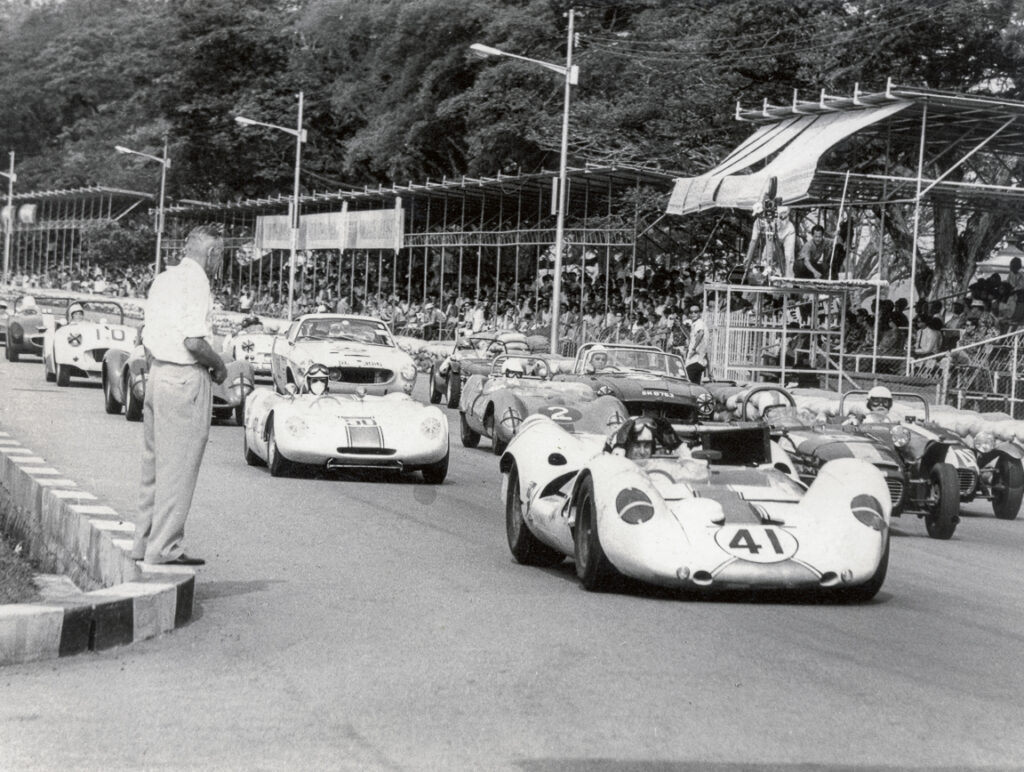
The 1967 Sports Cars race, Johore Grand Prix. #41 is John Macdonald in the Lotus 30/40. Peng Tsu Ying (No.48) is to the extreme right in his Lotus Super 7. Beside Peng is Lou de Marco’s Lotus Super 7 (No.61). Behind Macdonald are Hardy Burmester’s Team HK Lotus 23B (No.50) and Tan Keng Hian’s Lotus 17 (No.2). Behind Burmester is Jim Watkins’ Cooper Jaguar (see JUNGLE WARRIOR).
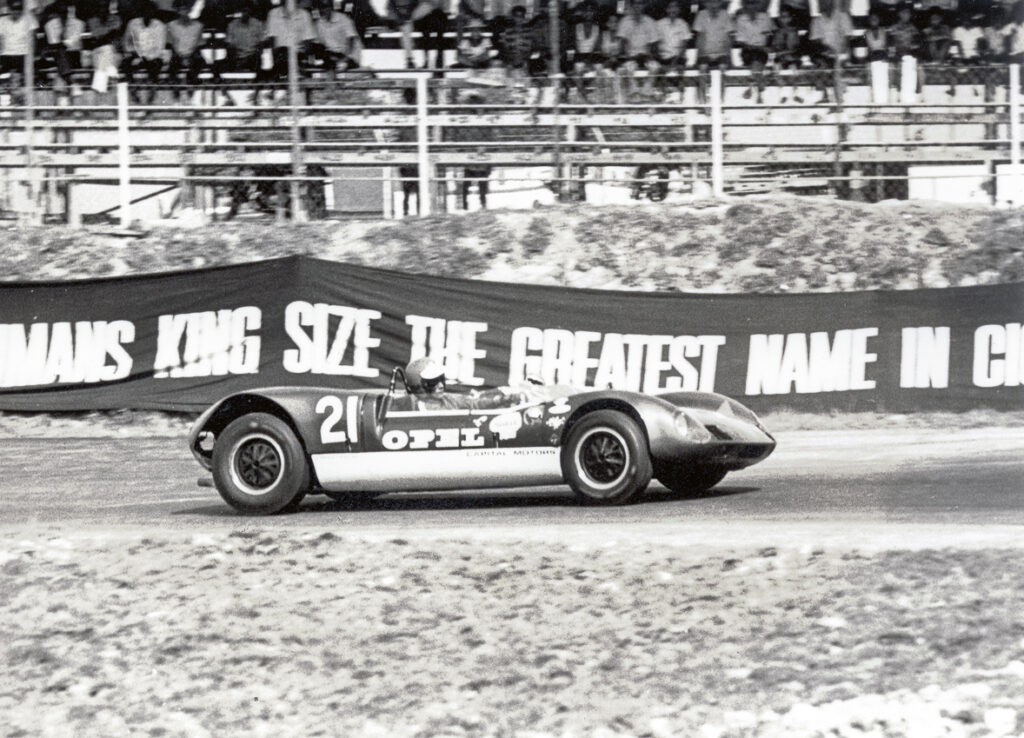
Rodney Seow in his Elva Mk7S Nerus-BMW. Rodney Seow started the Sports Car race from the back of the grid in the sports car race, having missed qualifying due to delays on the train journey from Kuala Lumpur to Johore. That was the only year they didn’t tow the car up from Singapore as there were too many cars handled by the Singapore Motors/Capital Motors team. The Elva finished second to Lee Han Seng (Lotus 23B) and set FTD!
Friday’s racing saw Lee Han Seng upset the odds in a thrilling Sports and GT race. Lee faced formidable competition from Macdonald and from Rodney Seow in the equally fast Elva Mk7S Nerus-BMW. It was a race that Macdonald, who started on pole, should have comfortably won, but the ex-John Dean Lotus was thwarted by a broken upright on lap 13. Rodney Seow, who had to start from the back of the grid, put up a fantastic performance and set fastest lap in the ex-Bob Waters Elva, but it wasn’t enough to catch his friend in the Lotus 23B. Lee finished tops, 8.1 seconds ahead of the very rapid Elva.
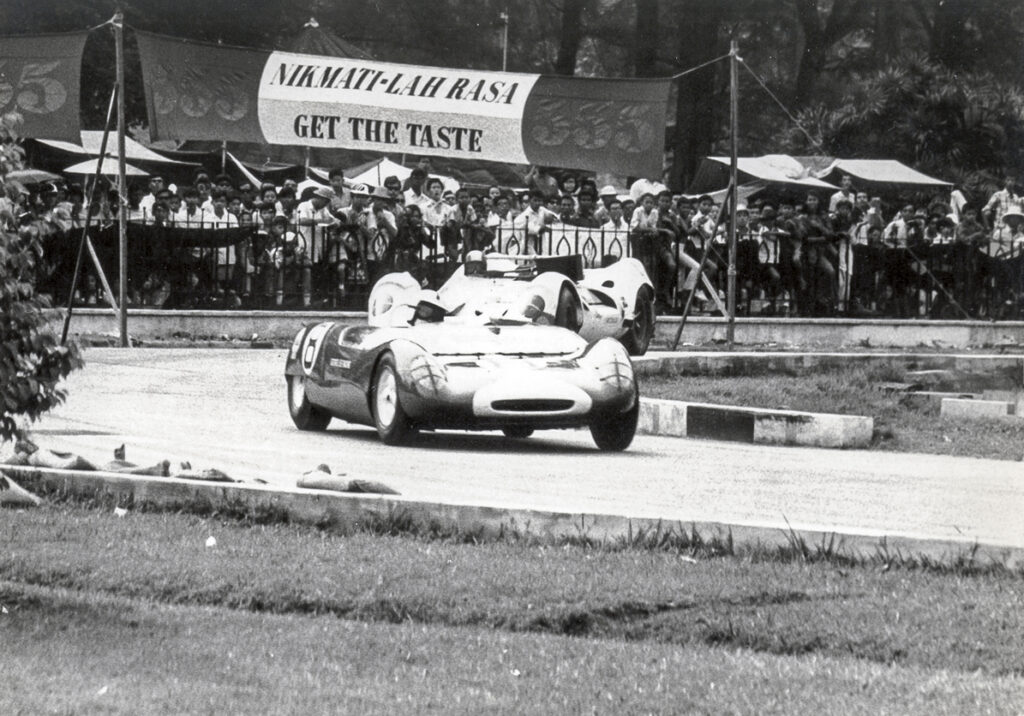
Lee Han Seng on his way to victory in the 1967 Johore GP Sports & GT race in his Lotus 23B. John Macdonald’s Lotus 30/40 trails, progressively falling apart.
OPEN WHEELERS, OPEN RACING
The Grand Prix grid went out for an early qualifying session on Friday and Rodney Seow put his Merlyn Mk10 on pole, with Lee Han Seng second in his Brabham BT18 and Stanley Leong a surprising third in the Elva Mk7S Nerus-BMW. Steve Holland was fourth in the Lotus 41 and Jan Bussell was fifth in his trick (read Howden Ganley) Brabham.
In the motorcycle Grand Prix qualifying, Hiroshi Hasegawa and Akiyasu Motohashi locked up the front row for Yamaha with Yoshimi Katayama in third for Suzuki. The Malaysians followed with Ou Teck Wing (Yamaha) ahead of Bulldog Kuan (Kawasaki) and Tham Bing Kwan (Tham Special). A young Lionel Chan, nephew of Singapore race legend Chan Lye Choon, was in a Guan Hoe-entered 249cc Suzuki.
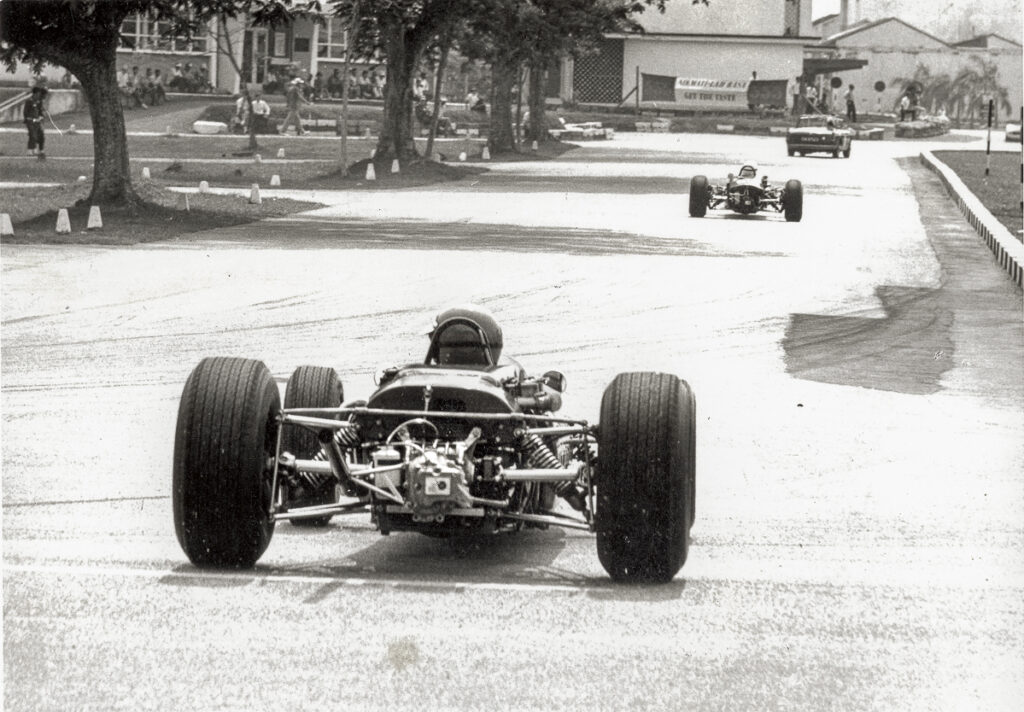
Lee Han Seng puts some space between his Brabham BT18 and the ailing Merlyn Mk10 of Rodney Seow as the pair head towards the Court House during the 1967 Johore Grand Prix. Lee went on to win the race.
The big races were scheduled for Saturday 9th September, Sunday being a working day in the State of Johore. The Saloon and Tourer support race took place at 9am, followed by the 60-lap Motorcycle Grand Prix at 10.30am, and the 60-lap Formula Libre Grand Prix at 3pm.
Albert Poon powered his now familiar No.66 Alfa Romeo GTA to a fine win in the Saloon and Tourer event, with Dickie Clinkard second in a Lotus Cortina and Ken Nelson third in a Mini Cooper S. Alan Bond finished fourth in his 2-litre Porsche 911S.
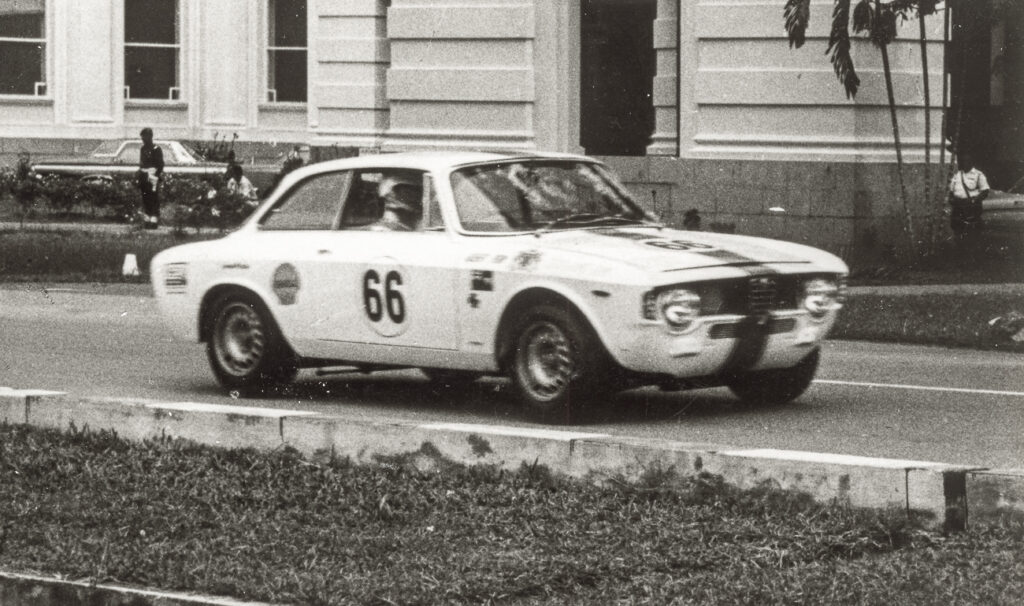
Albert Poon in his white GTA running under the Team Hong Kong banner in 1967. He won the Saloons & Tourers support race.
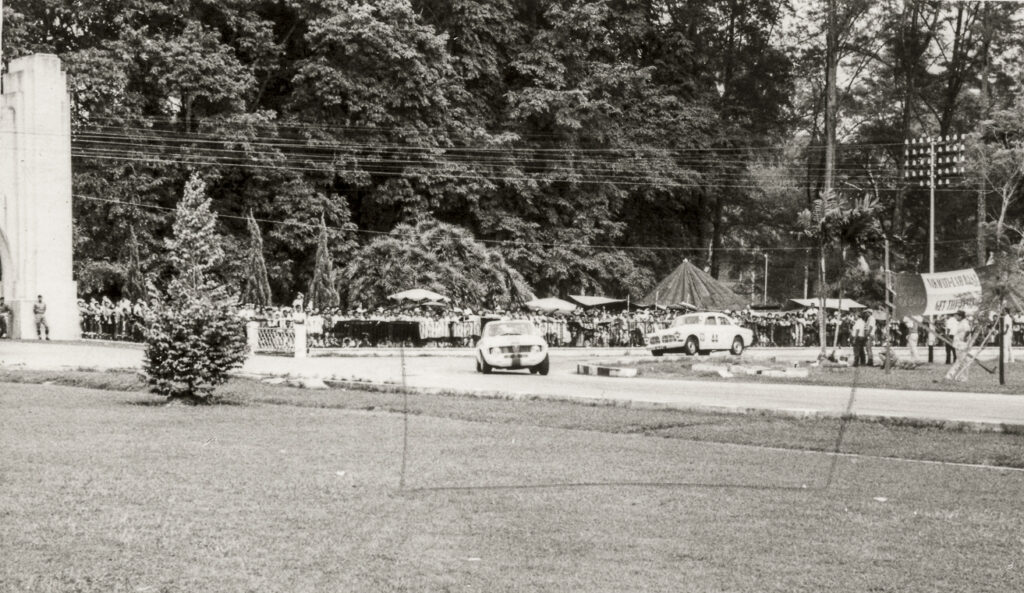
Albert Poon and his Team Hong Kong GTA, chased by the #44 Volvo of Raymond Tan Keng Hian during the Saloon & Tourer support race to the 1967 Johore Grand Prix. The GTA was later sold to Malaysian Alfa Romeo importers City Motors.
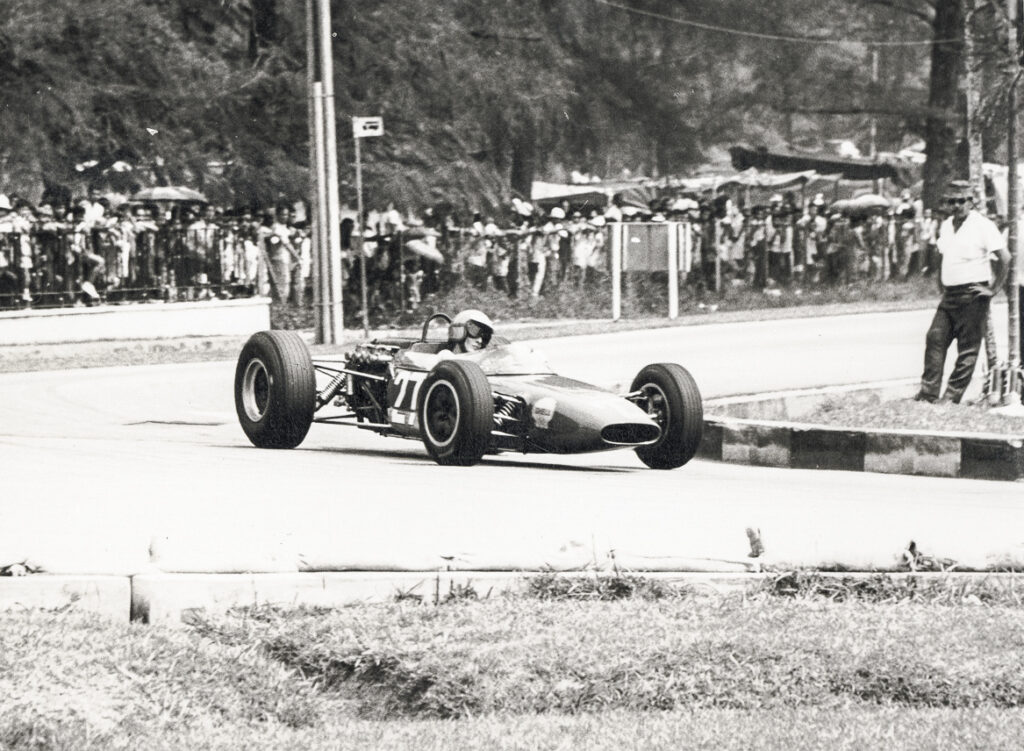
Rodney Seow powers his Merlyn Mk10 round Post Office Corner during the 1967 Johore Grand Prix. During the race, the Merlyn’s slave cylinder circlip dislodged, wrecking Rodney’s chances for a treble (he had won in Singapore and Batu Tiga that year).
BIG BIKES
The bikers went out shortly after for their Grand Prix. Suzuki’s Yoshimi Katayama upset the odds with victory ahead of Ou Teck Wing (Yamaha TD-1C), Penang’s Bulldog Kuan (Kawasaki) and Chris Howell (Suzuki), K.C. Wong (Norton) and Lionel Chan (Suzuki).
Hiroshi Hasegawa bagged FTD at 1min 42.5sec but failed to finish the race. Ou’s superb second place made up for the non-finishers of Yamaha’s top riders Hasegawa who suffered engine problems and Motohashi who had skidded out at Zoo Corner. Ou, a Malaysian Yamaha agency mechanic, attracted the attention of team boss M. Watanabe for his efforts and later received an invitation to race a works Yamaha at the Japanese Grand Prix that year.
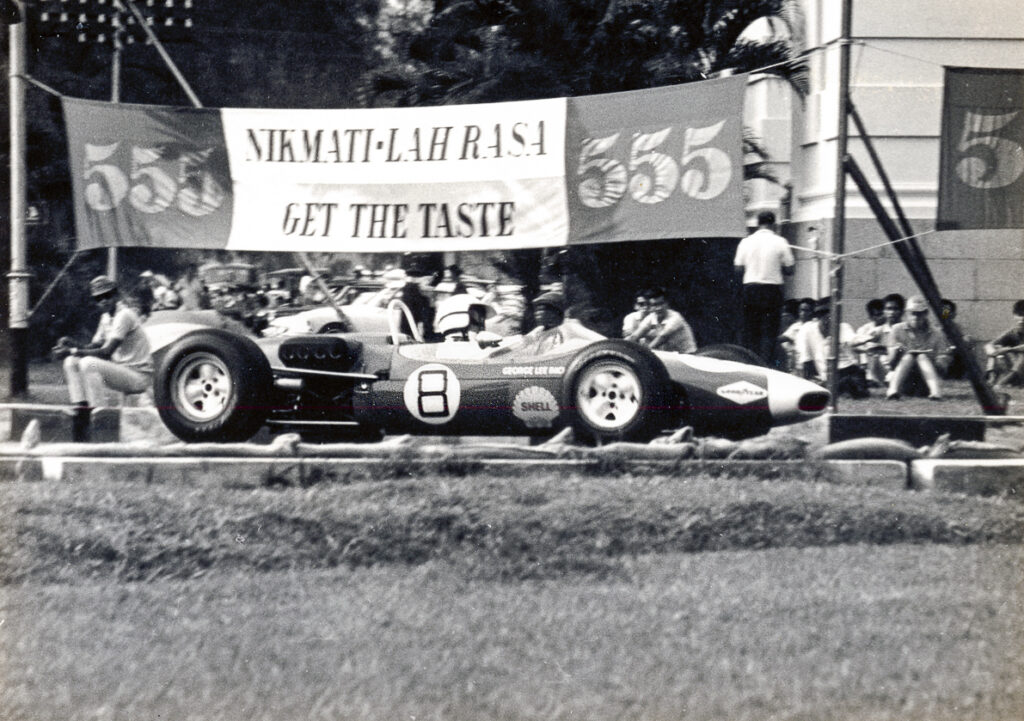
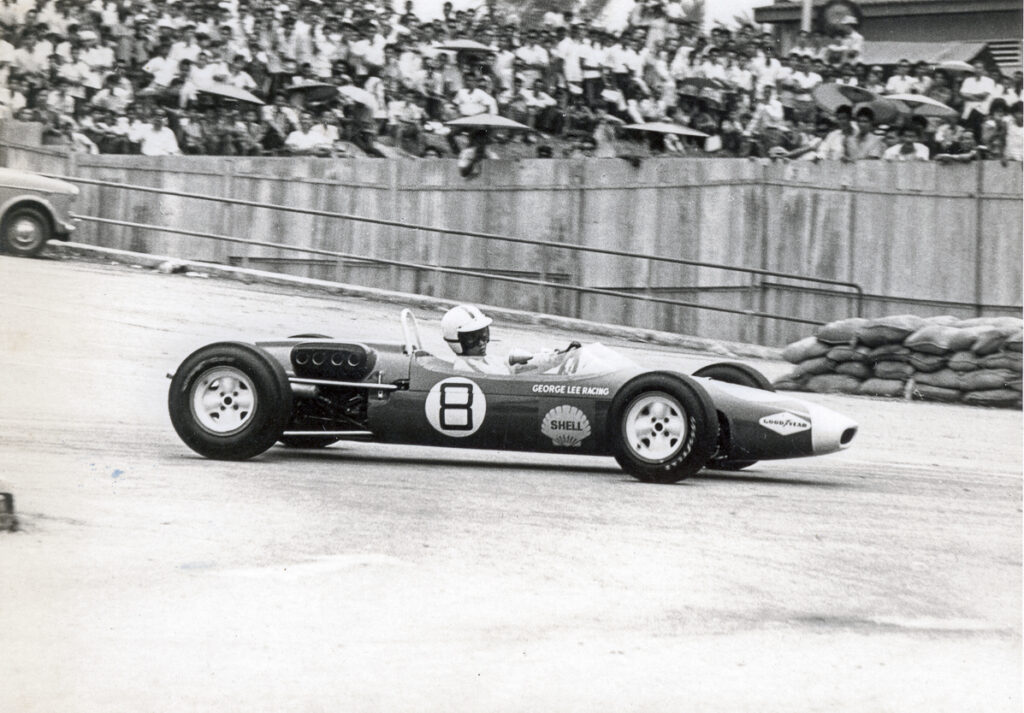
Lee Han Seng’s Brabham BT18 in action at Johore in 1967.
BIG BOYS
The Grand Prix for racing cars saw mixed fortunes for the Singapore drivers. Rodney Seow was first plagued by slower cars in his path, then by a detached clutch slave cylinder circlip and then by treacherous roadside curbs while Lee Han Seng, having fretted over the condition of his BRM Twin Cam (and replaced it late in the week with his Lotus Cortina Twin Cam motor), overcame the odds to register his first win in Johore.
Lee finished ahead of the fancied Steve Holland and his Lotus 41. Holland chased hard and set FTD at 1min 38.8sec, a new course record. Third was John Macdonald in Teddy Yip’s new-lease-of-life Lotus 22 (the ex-Han Seng car that had won the 1966 Singapore Grand Prix!), Macdonald’s Lotus 30/40 out cold after the upright broke earlier. Lee was thrilled, Macdonald was fuming, and Rodney Seow was just plain devastated by his misfortune.
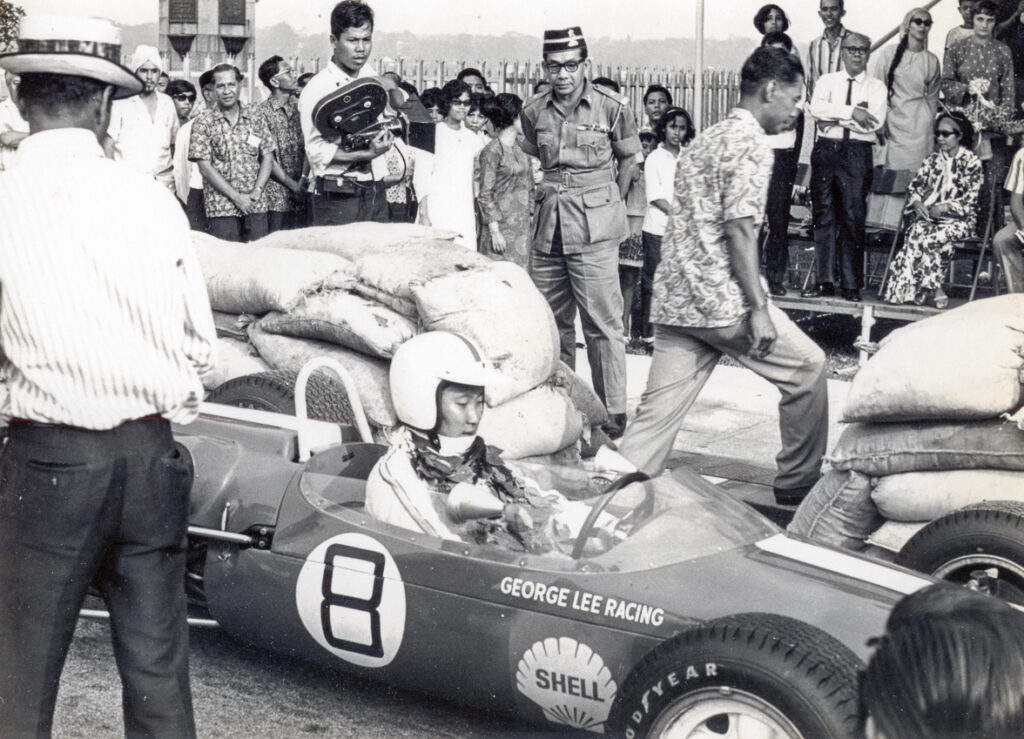
Lee Han Seng wins the 1967 Johore Grand Prix.
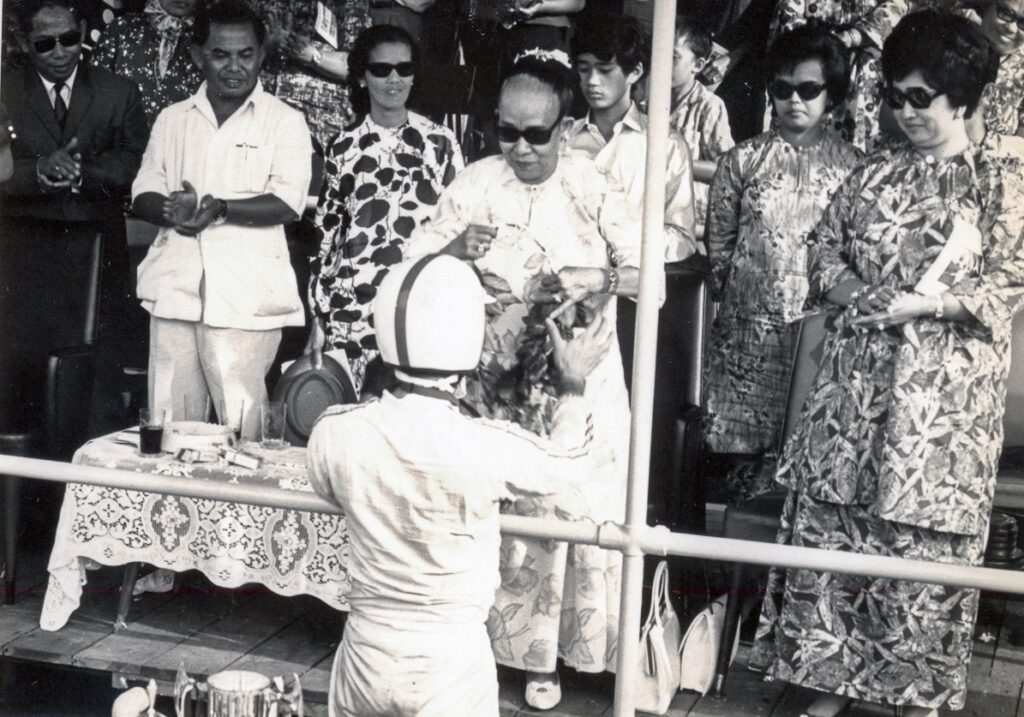
Lee Han Seng receives his 1967 Johore Grand Prix laurel and trophy from Sultanah Ungku Tun Amina binti Ungku Ahmad.
RACING PITFALLS
How would the Johore Grand Prix fare the following year, given strict customs requirements, taxes, cash bonds and loads of paperwork, on top of new entry and exit regulations at the Malaysia-Singapore checkpoint?
All these factors made it a major deterrent for the less affluent Singapore riders and, to a certain extent, the foreign riders as well. Several of the better-known riders opted out, including K.C. Wong, Soh Guan Bee, Looi Im Heok and Lee Wing Seng. Race team owners, such as the BOAC-Maple Leaf Team’s Tony Maw and Garrie Cooper, regarded the cash guarantees at Malaysian customs as a disincentive but, as the late Frank Gardner said, “When the flag drops, the Bullshit stops.”
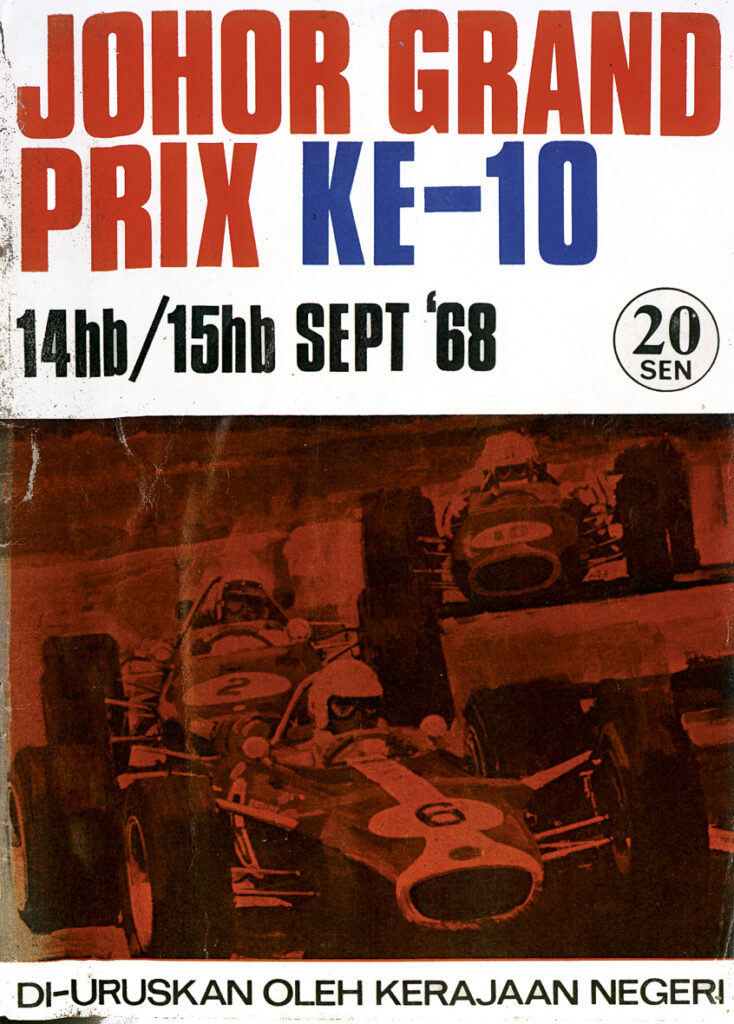
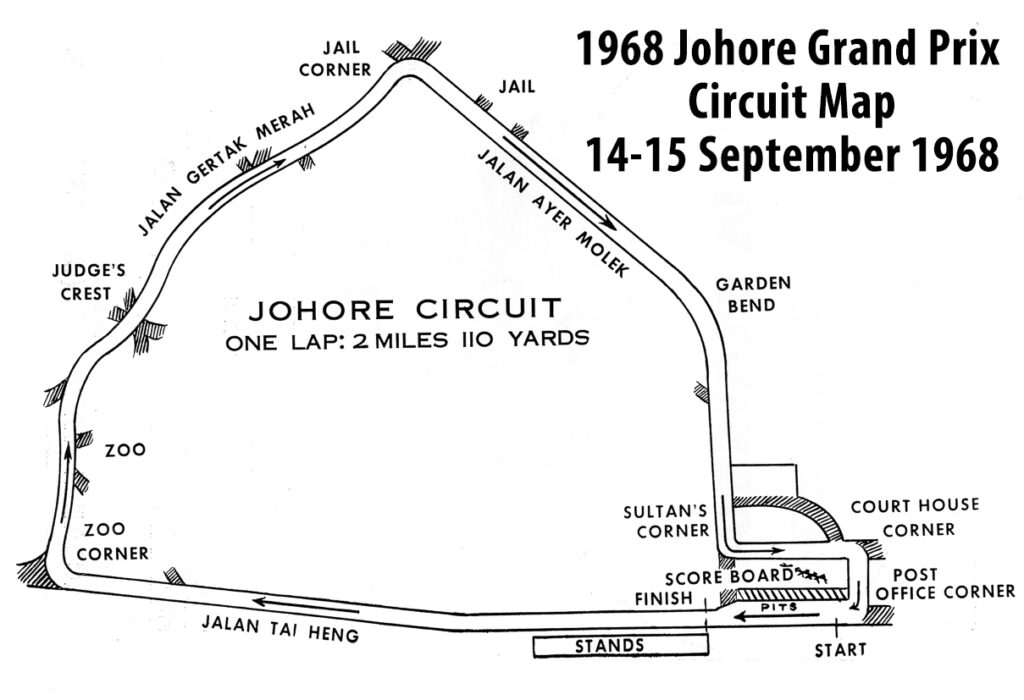
WHEN THE FLAG DROPS
For various reasons, the two 1967 Johore Grand Prix winners would not defend their respective titles for the 1968 Grand Prix. Prize money for 1968 had been bumped up from $25,000 to $30,000, with winners getting RM$5,000 each.
132 entries were received – 82 for bikes and 50 for cars. There were 25 entries for the Formula Libre Grand Prix, 27 for the motorcycle Grand Prix, so all the threats of withdrawals amounted to nothing once all the cars and bikes had cleared the first hurdle by making it to Batu Tiga for the First Malaysian Grand Prix on 7-8th September9.
In fact, 1968 would be remembered as a watershed year for South East Asian motor racing. It was the coming of age of the Singapore Grand Prix, where international competitors put the race on their maps. It was also the year Malaysia held its first Grand Prix, at the permanent Batu Tiga circuit.
There was a surge of interest from new teams for the glory of Grand Prix victory and one of them, P.H. Wong’s Newton Enterprise Racing from Singapore, was hell-bent on bringing in the best racers and cars to Asia. On Wong’s wish list were Australians Bob Holden, John Leffler and Max Stewart. His entries included Singapore residents as well. Newton Enterprise Racing’s olive green Mini Cooper S entries were just a teaser of things to come.
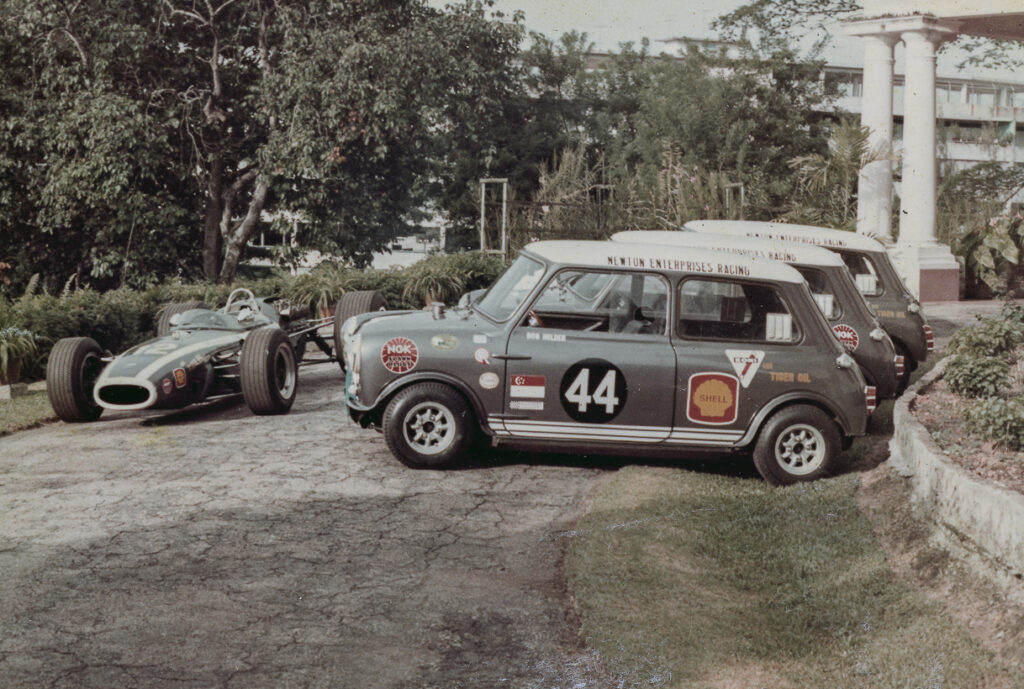
The Brabham Intercontinental and three Mini Cooper S outside S.Q. Wong’s Cairnhill home in Singapore. P.H. Wong had well-respected Australian race car engineer Geoff Smedley flown up to prepare the Brabham (chassis IC-3-64). The workshop area was “…just an open-sided building with an iron roof covered with some sort of tropical creeper which the groundsman/gardener trimmed each week.
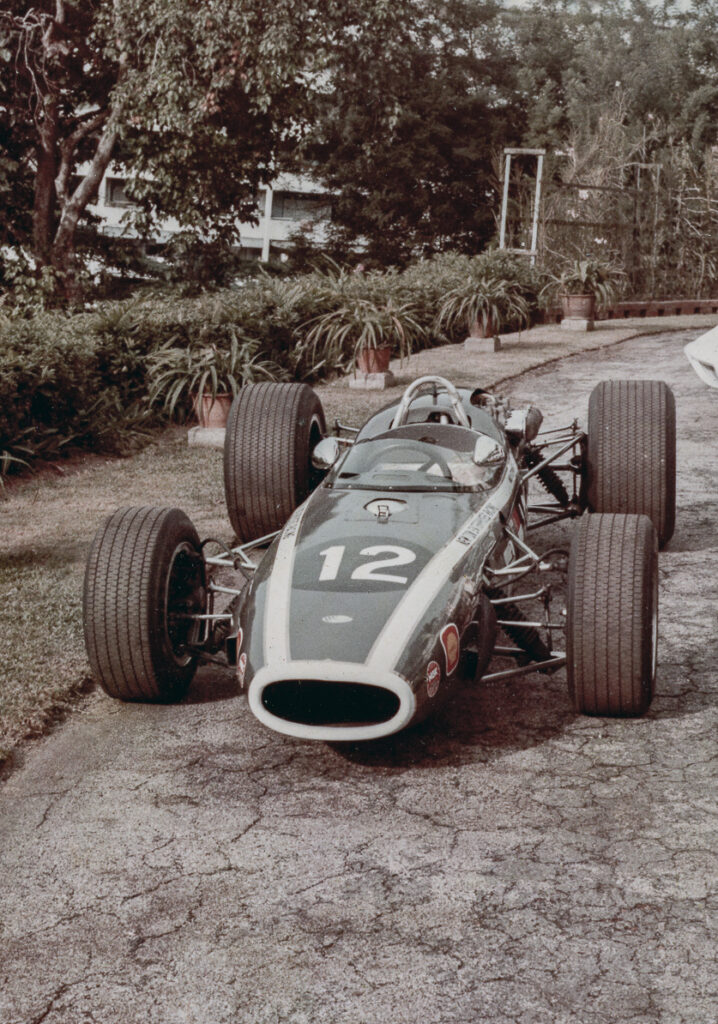
Top Australian race drivers Frank Gardner and Kevin Bartlett had raced this Brabham previously before it was brought into Singapore especially for Australians Allan Grice and 1967 1½-litre Australian champion Max Stewart to race. P.H. Wong had visited Sydney and inspected David McKay’s Scuderia Veloce Brabham Climax first, before a deal was struck with Alec Milden for his Brabham Climax instead. Geoff Smedley recalled that “…it seemed that it would have little opposition in Singapore.” The photo shows the car already painted in Newton Enterprises livery.
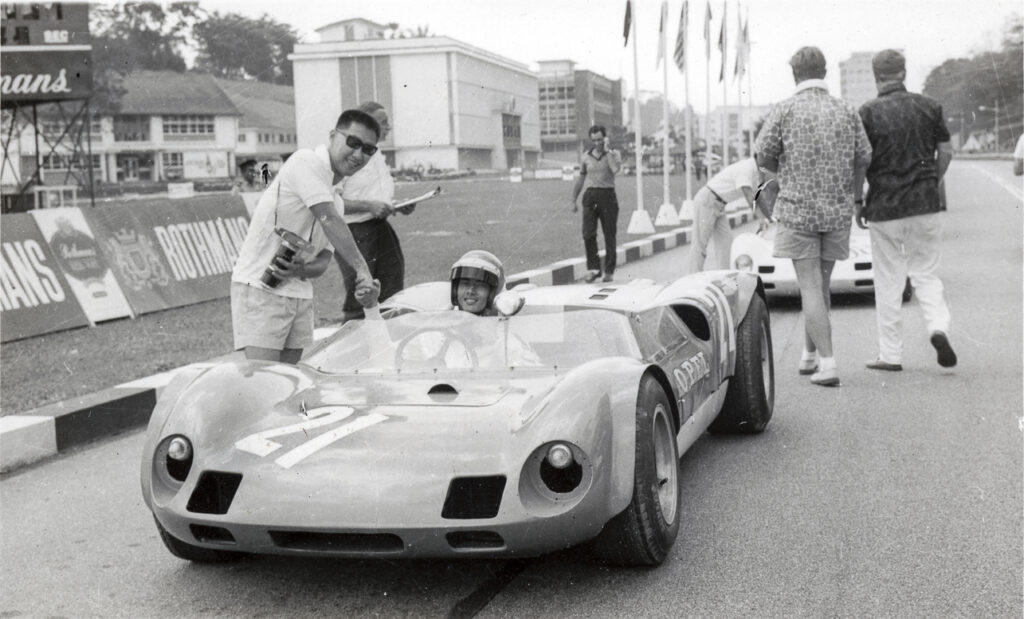
Elvas, Elvas everywhere… Rodney Seow in his Mk7S Nerus-BMW with Lee Han Seng by his side. Behind the M7S is the Elva M7 Climax, piloted by Rodney’s brother Philip Seow.
FAIRIES & FALLEN MINIS
All eyes were on Max Stewart in practice on Friday morning in Johore. His reputation in Australia made him the early favourite for the main race that consisted of four Brabhams, three Elfins, two Merlyns, a single Lotus single-seater, a fleet of Mini Coopers and five Lotus sports cars, amongst others.
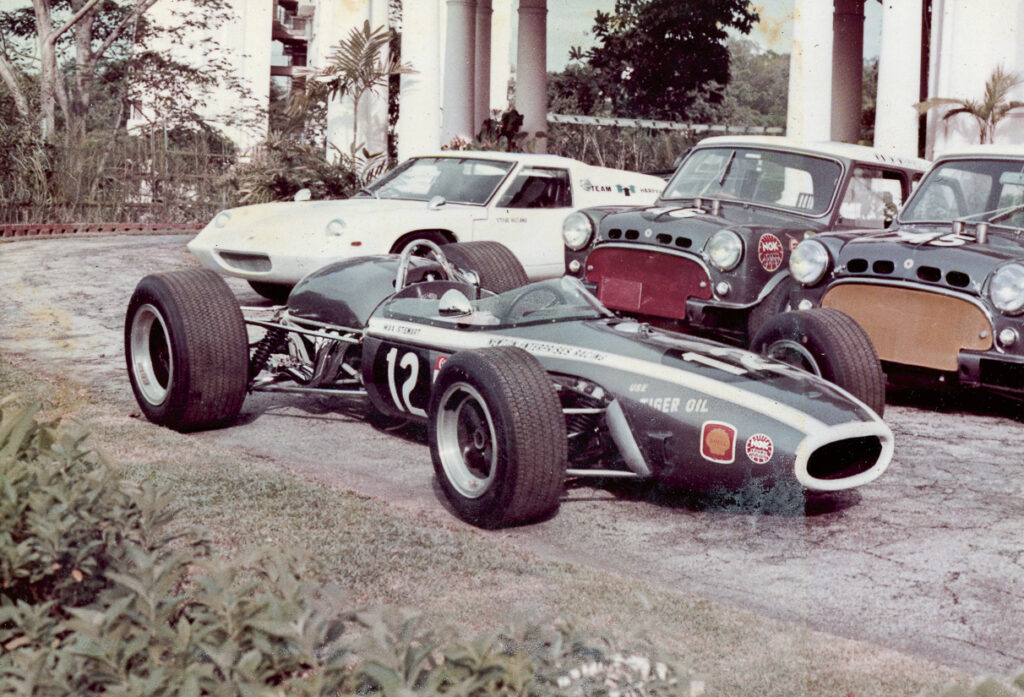
Wong Peng Hong’s role in the development and promotion of motor sports in Asia has never been sufficiently acknowledged. His Newton Enterprise Racing cars consisted of the No.12 Brabham BT11 and a trio of potent Minis, amongst many other cars.
The Brabham runners included Max “The Jolly Green Giant”, Mike Heathcote, Albert Poon and Jan Bussell. The likable Indonesian Henkie Iriawan had an Elfin 600B (the car that won the 1968 Singapore Grand Prix), Tony Maw had an Elfin 100 Mk2B and Mike Cook an Elfin Mono. Rodney Seow and Tony Mitchell had Merlyns, Rodney his Mk10, Mitchell, a Mk9 which had been purchased through Peter Gaydon.
Mitchell had meticulously worked out that his 1.6-litre Merlyn Twin Cam single-seater, with 40-50 litres of fuel in several tanks, and a consumption of around 10 miles per gallon (4.25km per litre), would require a splash and dash stop of three-plus gallon (11 plus litres) after 115 miles. The Johore Grand Prix was a 135-mile race over 60 laps, so there would be a need for a slash and dash, unless pannier tanks were added to a single-seater.
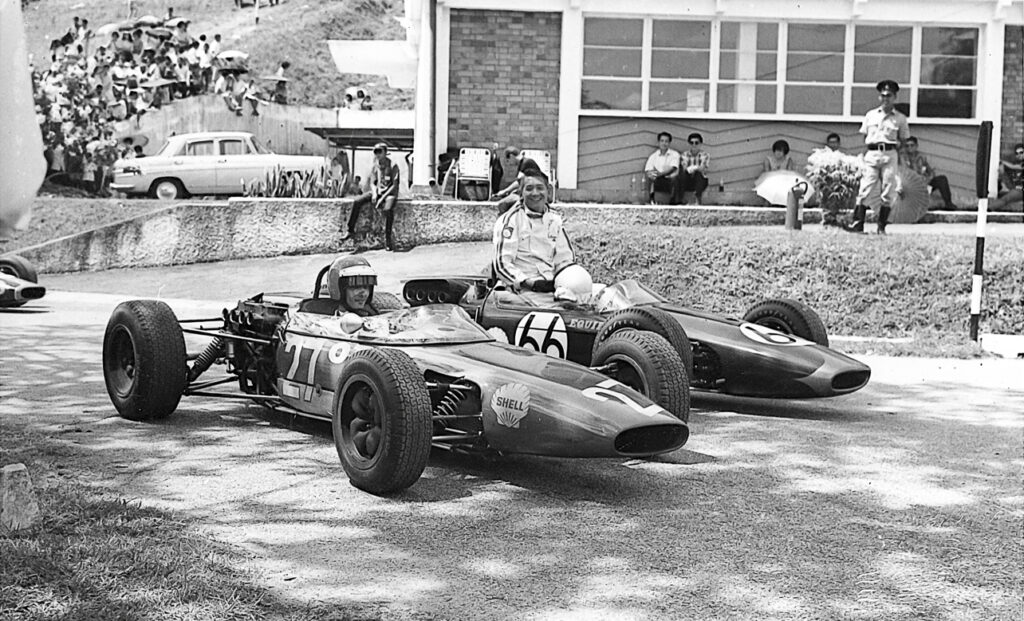
Lining up to head towards the start of the 1968 Johore Grand Prix are Rodney Seow (#27) and Albert Poon (#66).
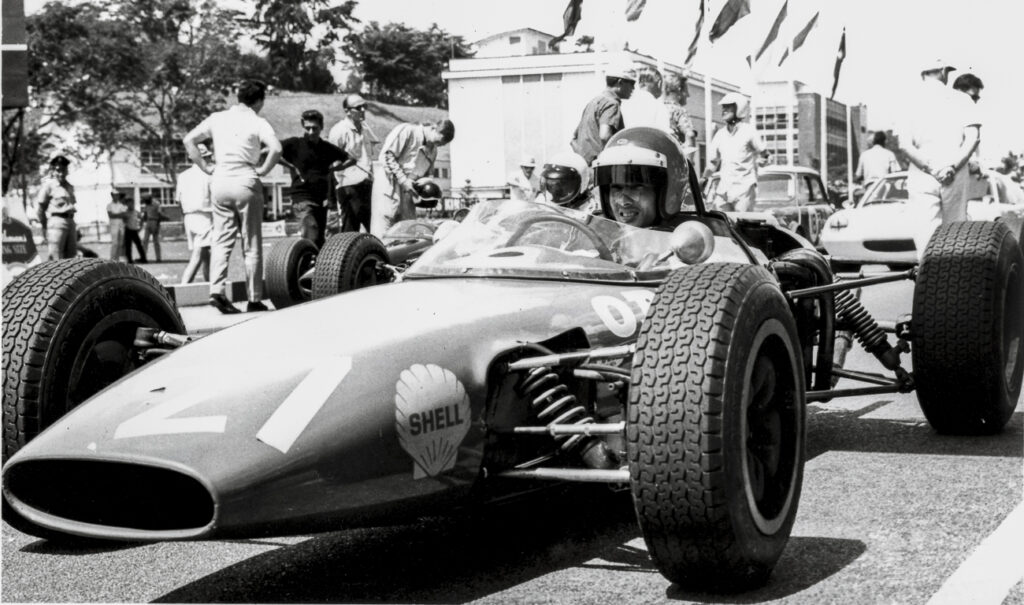
Front row view for Rodney Seow and his Merlyn Mk10. In the background: Steve Holland and his Lotus 47 from Hong Kong, and Steve Harvey in a Singapore-assembled Mini. To Rodney’s right are Jan Bussell (standing) and Albert Poon (seated).
Other weekend favourites included the regular Hong Kong names. Albert Poon now had a Brabham BT21A-Autodelta Alfa Romeo. The former Police Inspector and Hong Kong’s Alfa Romeo importer (Milan Motors) had shown his mettle when he won the First Selangor Circuit Race earlier in the year in the Brabham. Steve Holland had moved on from the Lotus 41 to a Lotus 47 sports car with fuel-injected Lotus-Ford Twin Cam motor.
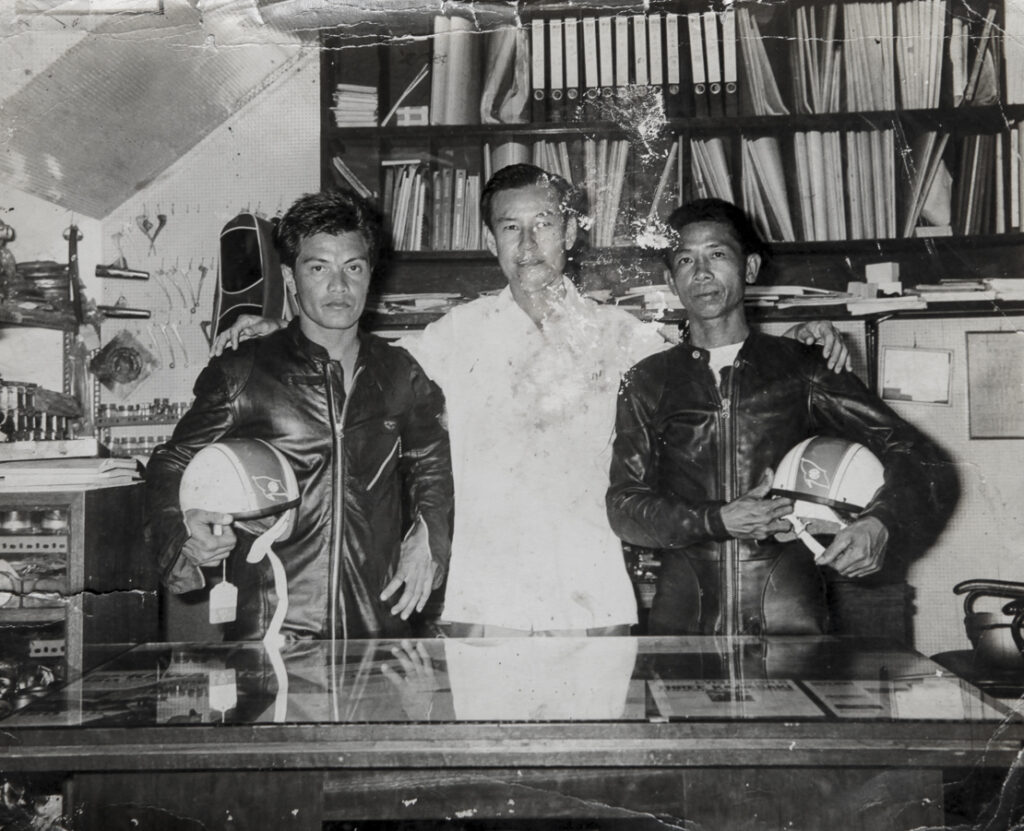
Malaysian motorcycle racing legend Bulldog Kuan was a regular in the Johore Grand Prix. Kawasaki importers Borneo Motors banked on two of their local riders for the races, Penangites Bulldog Kuan (right) and Chris Howell (left).
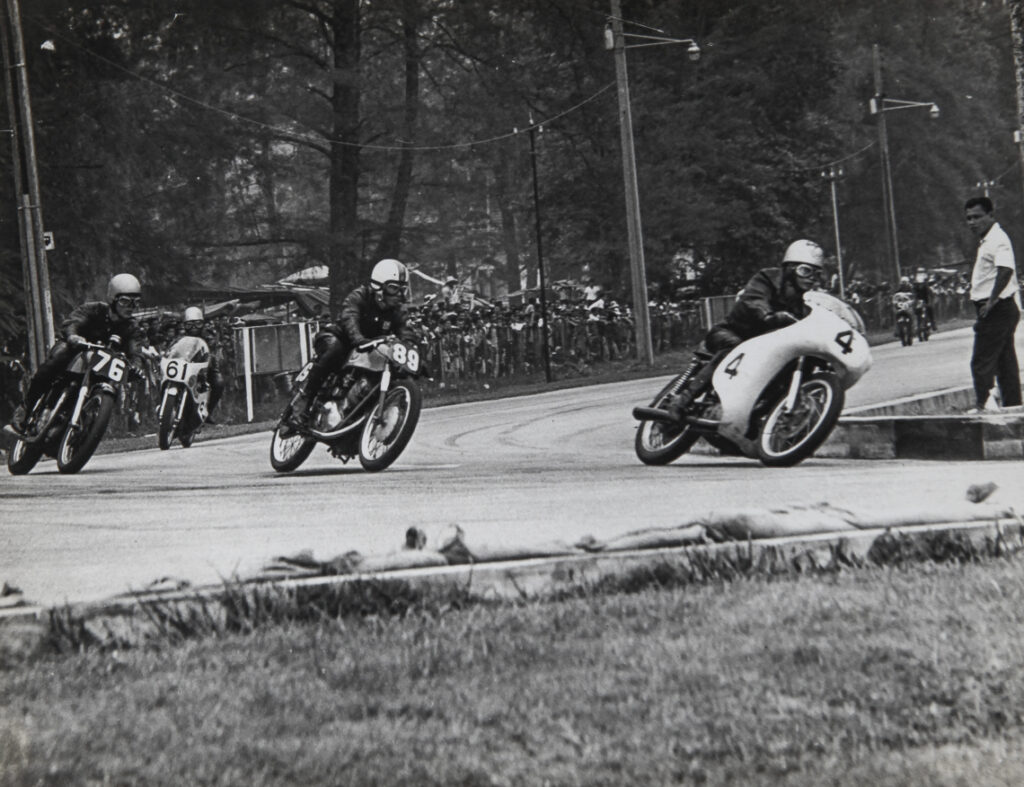
The 60-lap 1967 Johore Grand Prix for Motorcycles with Ng Yian Heng an his 252cc Ducati (#4) ahead of Tom Leong’s 250cc Leong Special (#89), N.R. Hinson in his 497cc Norton )#76) and Bulldog Kuan in his 247cc Kawasaki (#61).
JAPANESE DOMINATION
The Japanese domination in the motorcycle Grand Prix continued although the front row of the grid didn’t reflect that with Bulldog Kuan (Kawasaki) on pole and Ou Teck Wing (Yamaha) alongside. Hiroshi Hasegawa (started way back on the grid) and Akiyasu Motohashi (started in third place, ahead of Lionel Chan) sealed a 1-2 for Yamaha with Hasegawa setting a course record of 1:50.53.0 over the 60 laps race, beating Yoshimi Katayama’s (Suzuki) record set in 1967.
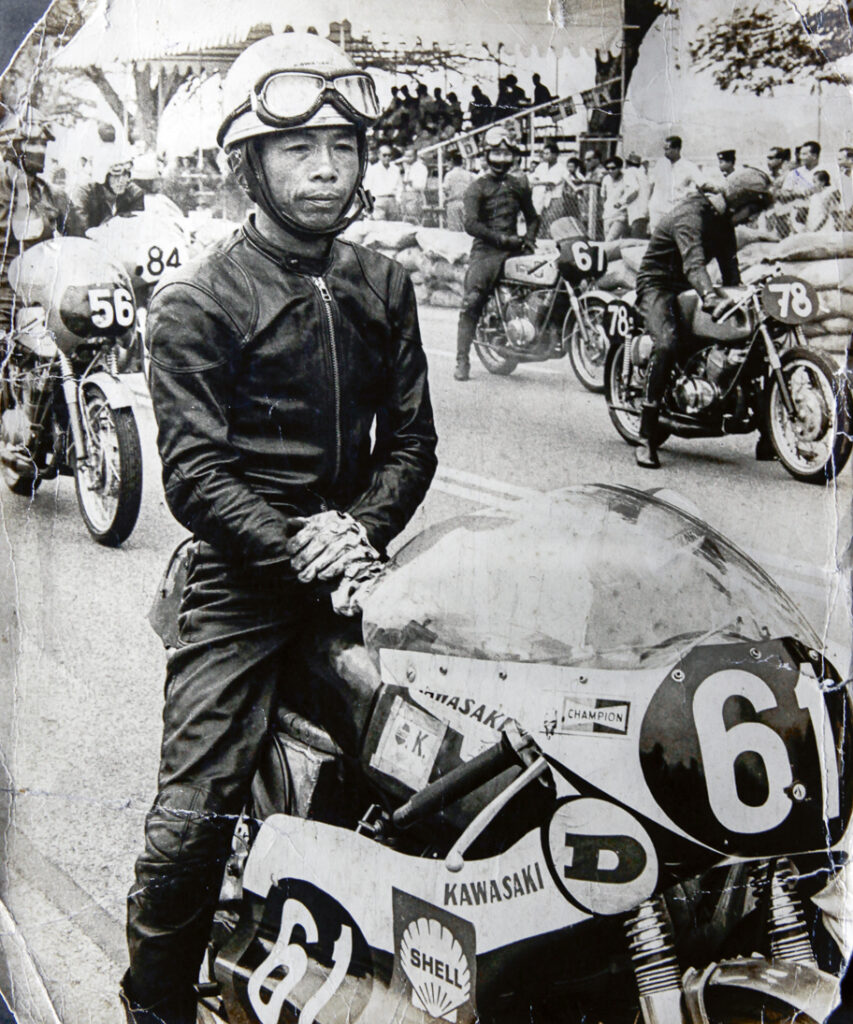
The 1968 Johore Grand Prix grid with Bulldog Kuan on his Kawasaki. #78 is Raymond Michael in the Soh Motors 247cc Suzuki; #67 Harry Tan in a 247cc Suzuki; #84 is Tham Beng Kwan in his 650cc Kwan Special; #56 is Lionel Chan in his 247cc Guan Hoe-entered Suzuki.
MINOR MINI MAYHEM
The Mini entrants also fancied themselves around the streets of Johore. It may have worked out for them in illegal street racing in Singapore but by 1968, racing was geared towards the big boys in their open-wheel Formula cars.
The little front-wheel-drive cars still provided a great deal of entertainment. In an unfortunate turn of events, Australian John Leffler had “lost” his Newton Enterprise Mini Cooper S on the way to Batu Tiga for the previous week’s Grand Prix. The Mini had slipped off the trailer while on tow along the highway, wrecking the bodywork. Leffler was compelled to borrow another car – there were the Minis of Bob Holden or Alan Davis to pick from for practice. The damaged car had its engine and suspension transplanted into another Mini body.
AND THEN IT RAINED
The 1968 Grand Prix was held on Sunday instead of Saturday as in previous years. There was a 45-minute postponement to the start of the race and this made all the difference.
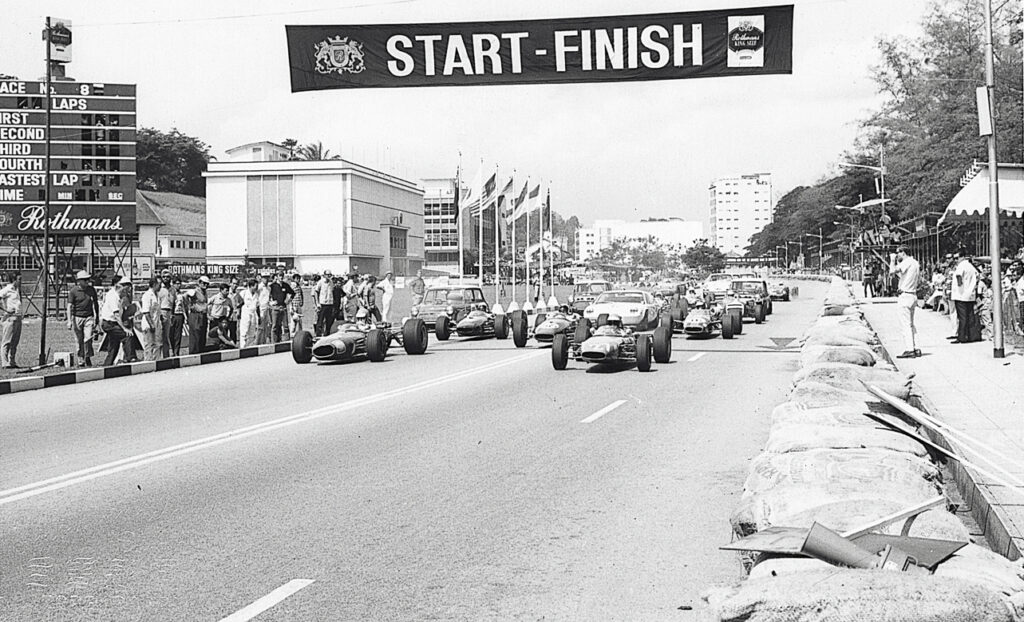
Grid Positions: Left #27 Rodney Seow – Merlyn Mk10; Right #12 Max Stewart – Brabham Intercontinental Climax 2.0 (pole at 1:31.1); Behind Rodney – #16 Hengkie Iriawan – Elfin 600B; Behind Max – two Brabhams – #10 of Jan Bussell with a Brabham ; Albert Poon in the #66 Brabham. On the sidewalk to the left of Rodney Seow is Dickie Arblaster. To the right of Dickie is the Sultan of Johore’s late brother (in dark glasses). Careful inspection and one may notice that the sidescreens of Max Stewart’s Brabham were missing – broken by the big man as he tried to get his frame into the cockpit of the car earlier.
Favourite Max Stewart took an early lead, but his race came to an inglorious end when his Brabham stalled at Zoo on the third lap, and just like at the weekend before, his race was over (it was vapour lock at Batu Tiga that ended it for him). Victory was up for grabs with Iriawan’s Elfin and Mitchell’s Merlyn vying for the lead.
Then all hell broke loose when the skies opened up. The torrential rain soon played havoc with the cars and several aquaplaned clear off the course.
Rodney Seow slid off at seafront straight into Zoo Corner. “I lifted off the throttle too quickly before Zoo corner and the car aquaplaned…did two or three spins on the road. I picked up the bodywork and placed it upright against a tree on the seafront, looked down the road and watched Alan Bond’s Porsche 911S, the Minis and Henkie’s Elfin spin off the track as well…I heard someone say afterwards that my car went up a tree,” he related with a chuckle to the writer.
Geoff Smedley, who was handling the Max Stewart New Enterprise Racing Brabham and the Minis, recalled the “…huge monsoonal downpour played havoc with the rest of the field, with cars left scattered around the race track and the positions of the few remaining competitors truly a guessing game.” 10
I heard someone say afterwards that my car went up a tree…
Rodney recalls Henkie Iriawan being led back to the pits where Joan Green, wife of RAC Steward Charles Green, inquired if the Indonesian needed assistance. “I’ll have tea with extra hot water” was his only reply. The Elfin 600 was so badly damaged after his 120mph “aquaplane clear off the circuit” that the car was bundled and shipped back to Garrie Cooper’s Elfin Cars in Adelaide to have it repaired in time for the Macau Grand Prix in November.
Tony Mitchell too had cause to be disappointed. In a letter to Peter Gaydon, Mitchell wrote: “…the car was leading when the race was stopped due to a torrential down-pour, but was subsequently disqualified because I had remained seated in the car during a refuelling stop!! This was disastrous to say the least as the prize money and bonus involved were considerable but the loss of face was even greater. During the course of this downpour, I had a monumental spin which I am told lasted for 200 yards and as a result of this, managed to crack a front wheel on a curb.”
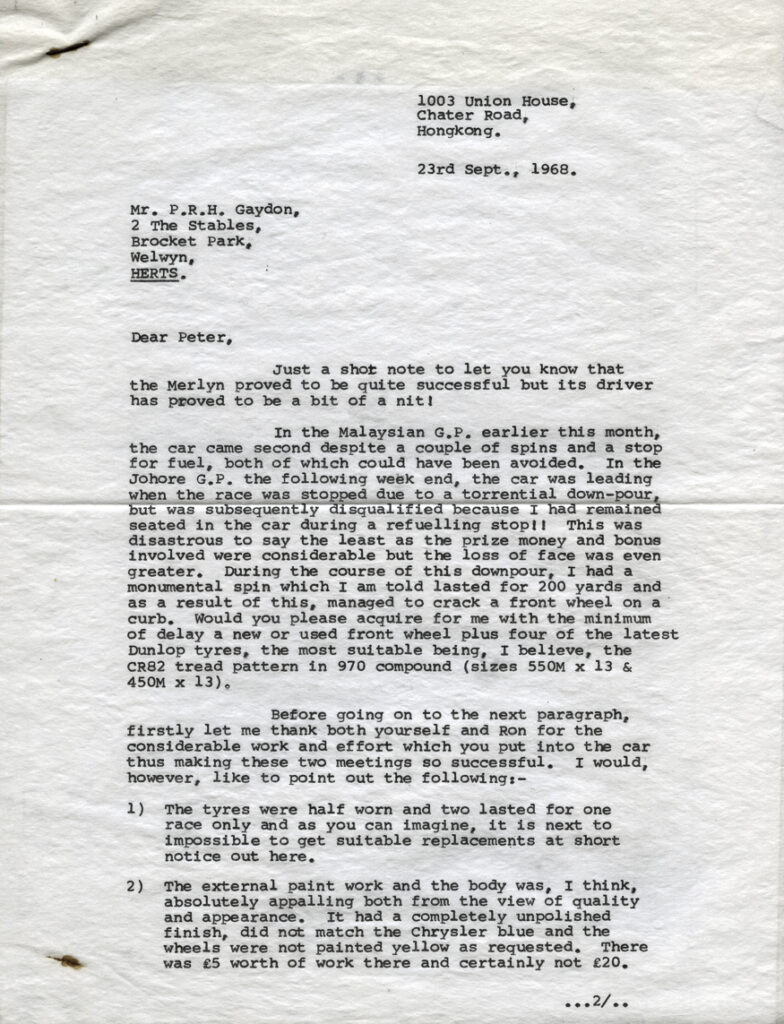
An interesting account of the 1968 Johore Grand Prix from this letter of Tony Mitchell to Peter Gaydon.
Curbs and the torrential downpour were what most of the competitors found the most daunting that weekend. The organisers reacted before the depleted grid was totally decimated. Out came the red flag and Lou de Marco, a Royal Air Force officer based in Singapore, was declared the winner in his Lotus Super 7.
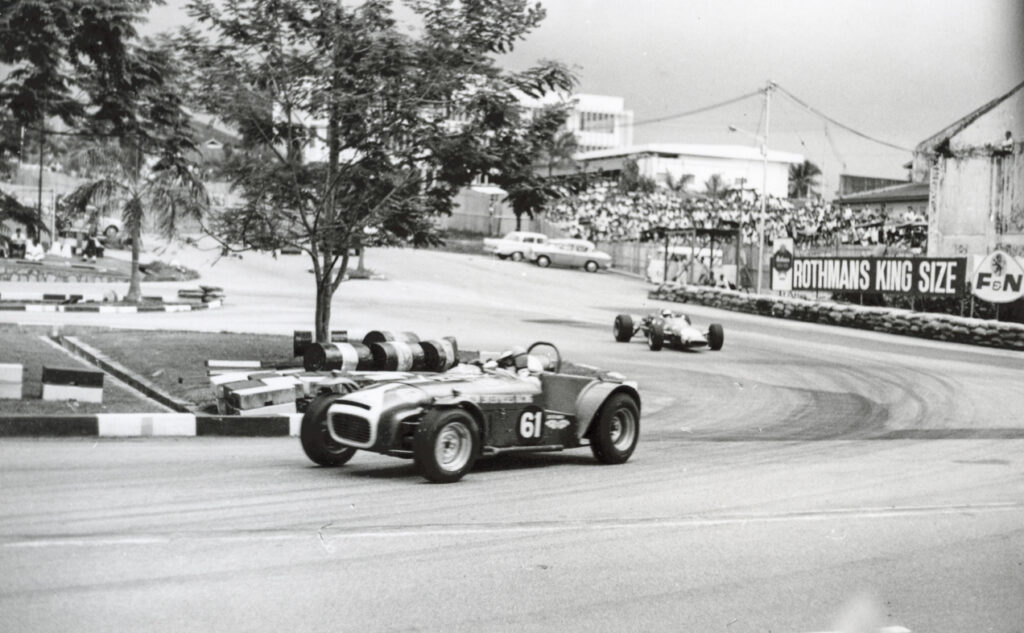
Lou De Marco in his Lotus Super Seven in Johore. The car, built as a kit in Singapore February 1966, was first raced by Jane Hadderly in the 1966 Singapore Grand Prix.
CONCLUSION
In 1969, there was no organisation or body prepared to come forward to run a Grand Prix around the streets of Johore. A contributory factor may have been the already-established Singapore and Selangor Grands Prix and overtures from Penang of an impending Grand Prix there as well. Johore was a well-liked venue and proximity to Singapore gave it exceptional coverage in the media as well as in spectator attendance. Plus it had Royal patronage. Nevertheless, it took another 18 years before the state hosted another Grand Prix…
For previous articles on the Johore Grand Prix see the following:
GENESIS & THE WINDS OF WAR – The 1940 WAR EFFORT GRAND PRIX
JOHORE GRAND PRIX – PART 1: 1949-1953
JOHORE GRAND PRIX – PART 2: 1960-1963
For references to the history of the Singapore Motor Club and the Malaysian Motor Sports Club, see CLUBBING IN SOUTH EAST ASIA
For reference to the early years of racing in Malaysia, see RACING IN THE FEDERAL CAPITAL
Contact me if you require a full of results for the Grand Prix and Support races for the 1949-1968 Johore Grand Prix.
Footnotes
- See MICKEY BOY’S BADGE
- See RACING IN THE FEDERAL CAPITAL
- See RACING IN THE FEDERAL CAPITAL
- See WHEN SMOKE GETS IN YOUR EYES
- The movie was released in the United States in December 1966. See https://en.wikipedia.org/wiki/Grand_Prix_(1966_film)
- https://en.wikipedia.org/wiki/Indonesia%E2%80%93Malaysia_confrontation
- Lotus 30 V8 Serial Number 1122, gearbox ZF 5DS20 Serial Number 51. Always one with a turn of words, Macdonald could only conclude that the 30/40 was a “30 but with 10 more mistakes.” The 4700cc engined Lotus 30/40 was purchased from John Dean in the summer of 1967 (Macdonald managed to test the car at Silverstone prior to purchase). Macdonald first raced it at the Tunku Abdul Raman meeting at the Batu Tiga circuit in 1967. It dropped a valve in practice and the welded up piston only lasted a few laps in the race. Macdonald raced the following weekend at the Johore Grand Prix where the “Brake calliper tore clean away from the upright” during practice. Teddy Yip kindly lent Macdonald the ex-Lee Han Seng Lotus 22 for the race itself. The 30/40 was then entered for the Macau Grand Prix on 19 November 1967 but suffered a radiator leak on the second lap. Macdonald used it in Hong Kong for some of the hillclimb events, setting FTD in at least one. The following year the car was entered for the Fuji 300 Yomiuri Asian Challenge Cup in Japan (on 24 March 1968) but DNF-ed. It was subsequently sold in Japan to a Mr. Katsuomi Shiozawa (a.k.a. George Katsu), organiser of the above event. He put his own body on the car (and called it the IMAI A-1/RSC Ford V8) which Macdonald commented “thus replacing the only beautiful thing about it”!
- Capital Motors was the assembly arm of Singapore Motors, handling the assembly of Opel cars out of the Tampoi, Johore facility.
- For background to the history of the permanent circuit at Batu Tiga, see RACING IN THE FEDERAL CAPITAL
- See It’s A Smedley Thing – You Wouldn’t Understand. An Autobiography by Geoff Smedley. Geoff Smedley, 2018.

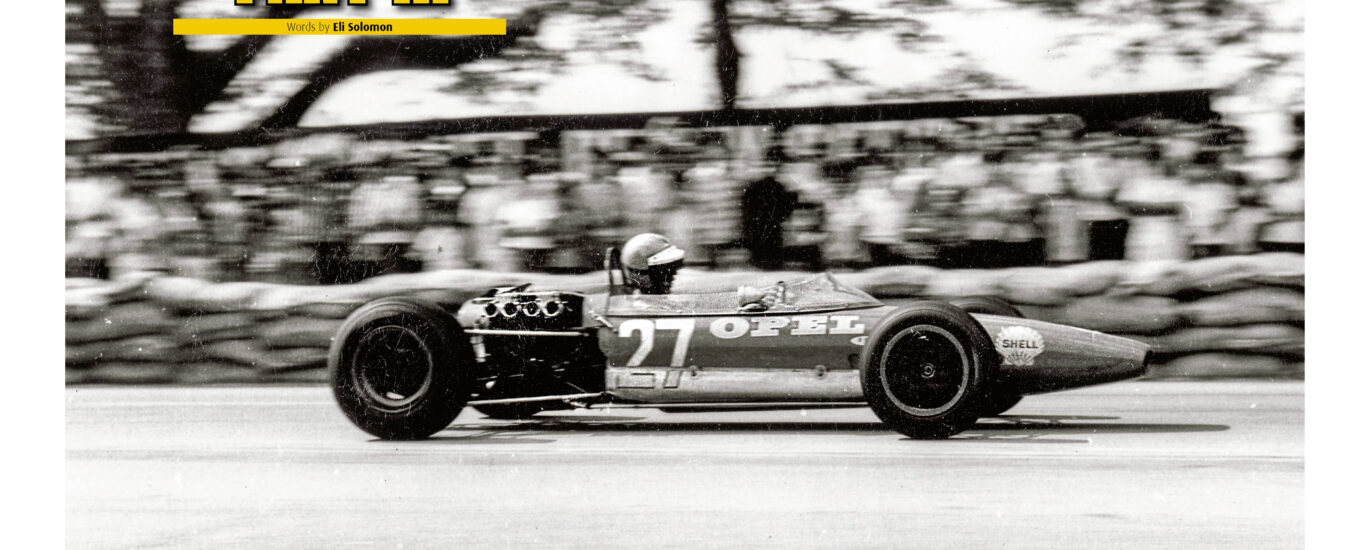
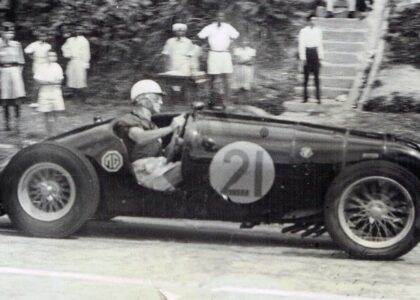
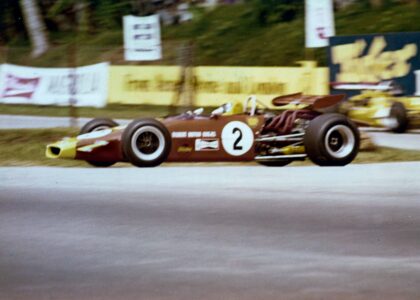
Just come across this page: great to see these photos, Eli, and a nice page design.
I still find these images exciting to look at, though more than half a century has passes since these events took place. Lots more to enjoy, I see. Thank you for putting this together!
Julian